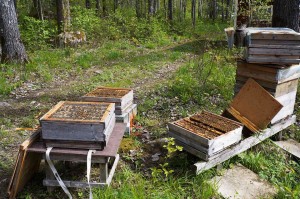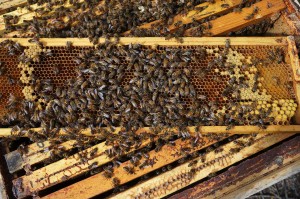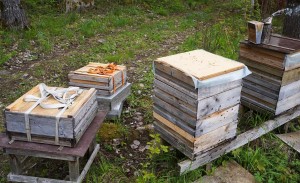A week ago I brought home the breeder queens for ease of grafting. They should at least have been treatment free last year (2013) and they should not have been a new colony 2013. The queen should be at least two years old. The colony could have been a new colony the year before (2012), or an old colony also then. It could have been a colony with an old queen that got shifted to a new one 2012 with an already laying one mated in a mini nuc. It could have been a failing colony due to varroa 2012, so it got some treatment then, queen removed and a mature queen cell. It could have been a walk away split from a strong overwinterer 2012, the split making its own queen. The colony is now, compared to the rest in the apiary, a strong colony, very little of dead bees in front of the hive, no signs of varroa problems, good tempered, at least above average in honey crop in 2013.
The brood area is on three 12 frame shallow boxes. Most probably the queen is in the upper third box. Sometimes though in the lowest first box. Using no smoke not top drive down the queen I carefully lift off the supers to the side, put the upper third box on a closed bottom, the same procedure with the second box.
Then I check the second box (or the upper third) for a broodframe with small larvae or eggs to make a queen from for the bees. I put in in the first bottom box that will be left on the stand. I have not checked for the queen. I know where she is, in one of the three boxes. I check the bottom box for brood. If there is very little brood, I take a brood frame from the upper third box as well. I just exchange the frames, take an empty frame from the bottom and put in the whole from where I took the broodframe.
If the bees are lively and fly a lot, which they shouldn’t as they are choosen for breeders, I have to be quick and put on the ventilated cover and strap the boxes to be moved to my home apiary. Both the taken boxes will be moved home. Most probably the queen is in one of them. It will show up quite quickly.
Now there is one brood box left on the old stand, could be without food frames as it was the bottom box. So I take a couple of food frames from my storage from removed food frames from last autumn which I took from colonies that were maybe a little weaker not filling up the three boxes and that were heavy of stores. They got insulation dummy frames at the sides instead. Those food frames I put at the sides in a new box and then fill up with empty drawn combs. This box I put under the brood box left. Then the queen excluder with the supers on top, now lifted back. If the queen should be left here I will exchange those two brood boxes with one of the splits taken home. It has almost never happened. Those queenless splits will make a new queen, and most probably not swarm with a virgin if left alone, as they are weakened (and from a breeder colony).
When I come home I put the splits with a similar made box underneath the split, if needed with food frames. It’s good to give them even if it’s no food crisis as they will not have many field bees, and especially the one with the queen will use the stores for brood.
The one with queen will be calm. The one without will usually be more nervous looking for their missing queen.



Hi Erik! Would be interested to see more about your use of Thymol. How when and why…I know you use these cardboards in front of the hive but how do you interpret what you see? How do you prepare and measure your treatment? I also use thymol (mixed with cooking oil) as a fall treatment, plus oxalic dribling in wintertime. Would like to add some resistance breeeding in as well. Thanks.
I will have that in mind. At the moment I’m so busy putting on supers and making splits. For some years now I have been making splits mainly from the best and let them make their own queen. But now I lost so few colonies and have so few bad ones needing thymol I have to concentrate on the bad ones, split them and give them mature queen cells. I’ll come back to what’s happening.
That is good to hear. We haad a horrible season here so far. Floods, and an incredible amount of rain during our main flow. Bees swarming like crazy.